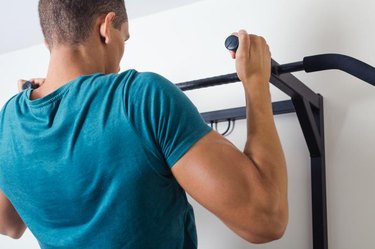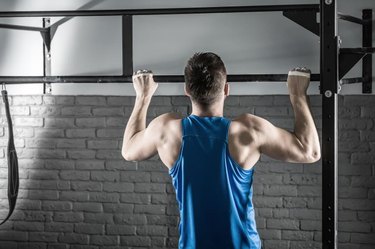
No membership fees, little or no equipment to take up space in your home and the ultimate portability — with advantages like these, it's no wonder that body-weight workouts have gained popularity among beginners and seasoned exercisers alike. With body-weight exercises, you use your own weight to create resistance to build strength.
If you're motivated by knowing something is a mass movement, it might help to know that body weight workouts climbed to the No. 1 spot on the American College of Sports Medicine's Worldwide Survey of Fitness Trends for 2015.
Video of the Day
Video of the Day
Alas, it slid to No. 2 for 2016, but while people may be fickle, body weight exercise is timeless. So let's forget about mass movements and make a move toward building muscle mass with these exercises.
Read more: Quickest Way to Improve Pull-ups
Push-Ups
If there's one body-weight exercise that deserves to be on everyone's list, it's the push-up. Push-ups work muscle groups in the chest, shoulders and spine. For added benefit, practice bracing your abdominal muscles as if somebody's about to punch you in the gut while you're pushing yourself up and down. This activates the transverse abdominus, a deep-lying core muscle that affects balance, gait and the lower back.
The basic push-up can be challenging when you're starting out but don't let that discourage you. If you're not up to pressing the full weight of your body yet, there's no shame in working your way up to it with one of these easier variations.
As you work up to three sets of 10 or more of any of these versions, you can begin adding in a couple of full push-ups at a time. Then try starting your workout with three full-ups, adding one every couple of days or so.
Half Push-Up
Begin by lying on your stomach with your arms pulled to your sides. Rather than pressing your whole body upward, use your knees as the pivot point. Keep a straight back while pressing upward with your lower legs remaining pressed into the floor. Push up until your arms are fully extended.
Read more: The 20 Best Body Weight Exercises
Incline Push-up
Pushing against an elevated surface such as a box or a heavy piece of furniture is a great way to work your way into full push-ups. Begin by placing your hands on the elevated surface at shoulder width. Brace your core muscles so that your body is straight and rigid from head to toe. Keep your legs together. Lower your chest to the box, then push upwards, engaging your chest and core. For an even easier variation, do the exercise standing upright at a slight incline and pushing against a wall.
Table Top Push-Up
Begin in a hands and knees ("table top") position, with your arms straight, your hands directly beneath your shoulders and your knees directly under your hips. Bending your elbows, lower your upper body slowly to the floor. When your nose is near the floor, press upward and return to the starting position. To add difficulty, cross your ankles and lift your lower legs into the air.

Pull-Ups
Pull-ups are among the most challenging of body-weight exercises, but their benefits are proportionate to their difficulty. They can help straighten your posture, enhance the strength of your grip, build arm muscles and work the stabilizing muscles that run the length of the spine.
Like push-ups, there's an entry-level degree of strength needed to get going with them. Try these exercises to prep your for the Full Monty. (For the record, pull-ups are done with an over-hand grip while chin-ups are under-handed. Most people find the latter easier on the rotator cuffs.)
Assisted Pull-Ups
Give yourself some support by hanging a resistance band around the pull-up handles. Band lengths vary, so depending on the size, place one or both feet or knees into the bottom loop. Now do a basic pull-up with the band tension helping to buoy your efforts.
TRX Biceps Curl
Most gyms have a suspension system such as TRX that leverages gravity and the user's body weight during exercise. Take the grips of the suspension system and lean backward with your arms straight. Turn your palms inward and bend your elbows, raising your body upward and drawing your hands to your chest. Slowly release and return to the starting position, keeping your body straight and rigid from head to toe.
Dips
For building strength and muscle mass in your chest, shoulders and triceps, you can't do much better than dips — once you're able to start doing them, anyway. It should be noted that dips should be approached cautiously if at all by people who've had shoulder problems. Here are a couple of ramp-ups on your way to the big dipper.
Bench Knee Dips
Bench knee dips will build your triceps and put you on your way to full-out dipping. Position yourself with your back to an exercise bench or other stable surface wide enough for you to place your hands on at shoulder width.
Place your hands on the bench behind your back with your palms down and lower yourself into chair position with your knees at right angles. Pulling your shoulders back, lower down until your elbows are at a 90-degree angle. Push back up and repeat.
Straight Leg Bench Dips
From a sitting position on a bench, press the bottom of your hands into the bench with your legs stretched out straight and your feet positioned away from the bench. Straightening your arms, slide your butt off the bench.
Lower your body behind your elbows until you feel a slight stretch in the chest or shoulders or your behind touches the ground. Lift upward to starting position and repeat.